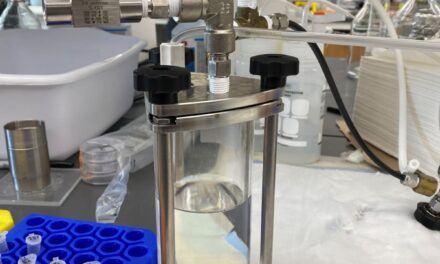 New leak detection technology available from the Belfast-based specialist machinery manufacturer, Sepha, is transforming the area of seal integrity testing of blister packs used in pharmaceuticals. Blisterscan technology is the subject of a whitepaper by University of Ulster School of Engineering packaging expert, Dr Dorian Dixon
New leak detection technology available from the Belfast-based specialist machinery manufacturer, Sepha, is transforming the area of seal integrity testing of blister packs used in pharmaceuticals. Blisterscan technology is the subject of a whitepaper by University of Ulster School of Engineering packaging expert, Dr Dorian Dixon
The current industry standard of testing seal integrity is blue-dye testing, but in some cases the difference in accuracy between the two methods in finding a defective blister pack could be as much as 10 per cent, according to Dr Dixon’s findings. In a global market valued at over $40 billion, a 10 per cent difference in a product being sealed correctly is said have a major impact on quality control and hence cost reduction.
In his whitepaper, Dr Dixon compares the ability of Blisterscan and the blue dye test to detect defective pockets in blister packs. The most widely used industry method for testing blister pack integrity is blue dye testing, while the Sepha Blisterscan is a dry, non-destructive technique using a laser to measure changes in the pack profile which result from applying a vacuum.
A preliminary study was conducted by Dr Dixon to determine the ability of Blisterscan to identify defects in a wide range of blister pack designs.
A ‘Design of Experiment’ approach was used to investigate the effect of pocket dimensions, foil thickness, pack material, and defect size on detection rates by both Blisterscan and blue dye testing. This study found that the Blisterscan test method found 100 per cent of 15µm sized holes while only 85 per cent of such defects were picked up by blue dye testing.
In his whitepaper study Dr Dixon compared the ability of Blisterscan and blue dye test to detect defective pockets in blister packs with 12µm or 20µm sized holes laser drilled in the packs to create defective packs. The defects were laser drilled in the approximate centre of the foil laminate covering each pocket and the dimensions of the holes were confirmed to a tolerance of +/-2µm using an electron microscope. Commenting on the results, Dr Dixon says: “Blisterscan testing is a rapid non-destructive test method which can detect the presence of 12um, 15um and 20um sized defects in pharmaceutical blister packaging with a higher degree of reliability than conventional blue dye testing. The non-subjective nature of Blisterscan testing removes the possibility of human error and reliance on operator judgement, which is a key in the correct identification of small holes using traditional blue dye testing.”
Sepha chief executive, John Harran comments on the significance of the whitepaper results: “In a global pharmaceutical manufacturing environment where quality control and cost reduction are key elements, the results of this study pose questions over the ability of current blister pack integrity test procedures to deliver consistent and accurate levels of quality control. Dr Dixon’s conclusion would suggest that the industry should consider the more modern, appropriate, and accurate test verification methods that are available to them.”



